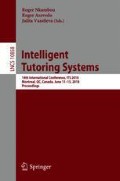Abstract
Digital doppelgangers are virtual humans that highly resemble the real self but behave independently. An emerging computer animation technology makes the creation of digital doppelgangers an accessible reality. This allows researchers in pedagogical agents to explore previously unexplorable research questions, such as how does increasing the similarity in appearance between the agent and the student impact learning. This paper discusses the design and evaluation of a digital doppelganger as a virtual listener in a learning-by-explaining paradigm. Results offer insight into the promise and limitation of this novel technology.
Access this chapter
Tax calculation will be finalised at checkout
Purchases are for personal use only
References
Johnson, W.L., Rickel, J.W., Lester, J.C., et al.: Animated pedagogical agents: face-to-face interaction in interactive learning environments. Int. J. Artif. Intell. Educ. 11(1), 47–78 (2000)
Lester, J.C., Converse, S.A., Kahler, S.E., Barlow, S.T., Stone, B.A., Bhogal, R.S.: The persona effect: affective impact of animated pedagogical agents. In: Proceedings of Human Factors in Computing Systems, pp. 359–366. ACM (1997)
Johnson, W.L., Rickel, J.: Steve: an animated pedagogical agent for procedural training in virtual environments. SIGART 8(1–4), 16–21 (1997)
Lester, J.C., Stone, B.A.: Increasing believability in animated pedagogical agents. In: Proceedings of Autonomous Agents, pp. 16–21. ACM (1997)
Craig, S.D., Gholson, B., Driscoll, D.M.: Animated pedagogical agents in multimedia educational environments: effects of agent properties, picture features and redundancy. J. Educ. Psychol. 94(2), 428 (2002)
Person, N.K.: Autotutor improves deep learning of computer literacy: is it the dialog or the talking head? AI Educ. 97, 47 (2003)
Wang, N., Johnson, W.L., Mayer, R.E., Rizzo, P., Shaw, E., Collins, H.: The politeness effect: pedagogical agents and learning outcomes. Int. J. Hum.-Comput. Stud. 66(2), 98–112 (2008)
Biswas, G., Jeong, H., Kinnebrew, J.S., Sulcer, B., Roscoe, R.: Measuring self-regulated learning skills through social interactions in a teachable agent environment. Res. Practice Tech. Enhanced Learn. 5(02), 123–152 (2010)
Baylor, A.L., Kim, Y.: Pedagogical agent design: the impact of agent realism, gender, ethnicity, and instructional role. In: Lester, J.C., Vicari, R.M., Paraguaçu, F. (eds.) ITS 2004. LNCS, vol. 3220, pp. 592–603. Springer, Heidelberg (2004). https://doi.org/10.1007/978-3-540-30139-4_56
Veletsianos, G.: Contextually relevant pedagogical agents: visual appearance, stereotypes, and first impressions and their impact on learning. Comput. Educ. 55(2), 576–585 (2010)
Domagk, S.: Do pedagogical agents facilitate learner motivation and learning outcomes? J. Media Psychol. 22, 84–97 (2010)
Schroeder, N.L., Adesope, O.O., Gilbert, R.B.: How effective are pedagogical agents for learning? A meta-analytic review. J. Educ. Comput. Res. 49(1), 1–39 (2013)
Finkelstein, S., Yarzebinski, E., Vaughn, C., Ogan, A., Cassell, J.: The effects of culturally congruent educational technologies on student achievement. In: Lane, H.C., Yacef, K., Mostow, J., Pavlik, P. (eds.) AIED 2013. LNCS (LNAI), vol. 7926, pp. 493–502. Springer, Heidelberg (2013). https://doi.org/10.1007/978-3-642-39112-5_50
Bailenson, J.N.: Doppelgangers-a new form of self? Psychologist 25(1), 36–38 (2012)
Shapiro, A., Feng, A., Wang, R., Li, H., Bolas, M., Medioni, G., Suma, E.: Rapid avatar capture and simulation using commodity depth sensors. Comput. Anim. Virtual Worlds 25(3–4), 201–211 (2014)
Gratch, J., Wang, N., Okhmatovskaia, A., Lamothe, F., Morales, M., van der Werf, R.J., Morency, L.-P.: Can virtual humans be more engaging than real ones? In: Jacko, J.A. (ed.) HCI 2007. LNCS, vol. 4552, pp. 286–297. Springer, Heidelberg (2007). https://doi.org/10.1007/978-3-540-73110-8_30
Chi, M.T., Siler, S.A., Jeong, H., Yamauchi, T., Hausmann, R.G.: Learning from human tutoring. Cogn. Sci. 25(4), 471–533 (2001)
Rosenberg, M.: Society & the Adolescent Self-image. Princeton University Press, Princeton (2015)
Leone, J.E., Mullin, E.M., Maurer-Starks, S.S., Rovito, M.J.: The adolescent body image satisfaction scale for males: exploratory factor analysis and implications for strength and conditioning professionals. J. Strength Cond. Res. 28(9), 2657–2668 (2014)
IPIP, Preliminary IPIP Scales Measuring Constructs Similar to Those Included in Lee and Ashton’s HEXACO Personality Inventory (2015). Accessed 2015. http://ipip.ori.org/newHEXACO_PI_key.htm#Anxiety
Witmer, B.G., Jerome, C.J., Singer, M.J.: The factor structure of the presence questionnaire. Presence 14(3), 298–312 (2005)
Fox, J., Bailenson, J.N.: Virtual self-modeling: the effects of vicarious reinforcement and identification on exercise behaviors. Media Psychol. 12(1), 1–25 (2009)
Feng, A., Rosenberg, E.S., Shapiro, A.: Just-in-time, viable, 3-D avatars from scans. Comput. Anim. Virtual Worlds 28(3–4) (2017)
Acknowledgment
This work is supported by the US Army Research Laboratory. Statements expressed do not necessarily reflect the position or the policy of the United States Government. No official endorsement should be inferred.
Author information
Authors and Affiliations
Corresponding author
Editor information
Editors and Affiliations
Rights and permissions
Copyright information
© 2018 Springer International Publishing AG, part of Springer Nature
About this paper
Cite this paper
Wang, N. et al. (2018). Learning by Explaining to a Digital Doppelganger. In: Nkambou, R., Azevedo, R., Vassileva, J. (eds) Intelligent Tutoring Systems. ITS 2018. Lecture Notes in Computer Science(), vol 10858. Springer, Cham. https://doi.org/10.1007/978-3-319-91464-0_25
Download citation
DOI: https://doi.org/10.1007/978-3-319-91464-0_25
Published:
Publisher Name: Springer, Cham
Print ISBN: 978-3-319-91463-3
Online ISBN: 978-3-319-91464-0
eBook Packages: Computer ScienceComputer Science (R0)

